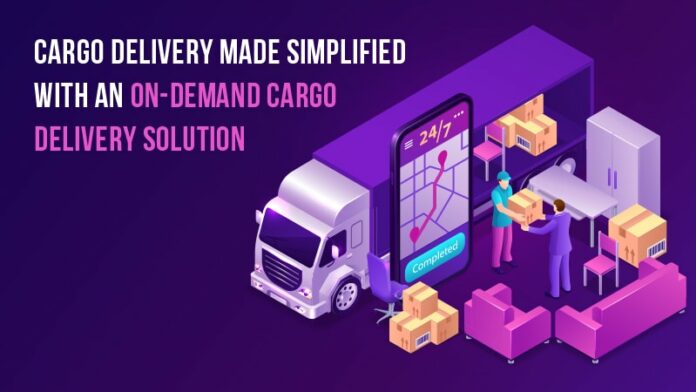
The On-demand Cargo Delivery Apps for a large share of the market among many Uber-like start-ups of recent days. These applications act as portals that connect consumers to providers of services. Yalantis has been working on numerous cargo delivery applications on-demand.
There might seem to be a great connection with on-demand supply apps and Uber-like cab systems, but not particularly their architecture. We will concentrate on what these two kinds of applications distinguish and address the steps we take in the creation of an on-demand freight distribution system.
The ten stages of design for On-demand Cargo delivery Apps are:
Consider on the on-demand service framework on the main screens and modules
Many cargo transmission systems include a range of displays and panel elements that can be used in all applications of this type with small differences. Especially if your business begins with an MVP it can be hard to determine where to concentrate your efforts.
- Order list – a list of supply orders to be processed by suppliers and submitted for bidding, emerges on the first panel.
- Shipping Card – a different entry in the order log. Each shipment card contains the most relevant detail about the unique order.
- Statistics for distribution – more specifics under the supply card itself providing full information on the order: customer name, order status, existing deals, type of goods and shipment weight, location, etc.; updates in this portion of the screen to represent the delivery date.
- Distribution Dashboard – the screen displays after the order specifics have been negotiated between the customer and the supplier, and the distribution is ongoing. The Delivery Dashboard is a concise summary of the Delivery Card, which features a planned route and the progress of the shipment.
- References – a collection of shipping cards approved by a specific contractor.
- Active Processing – a list of recent shipments.
A larger range of displays and interface elements and dynamic configurations are important for cargo delivery applications.
You have to give particular attention to the delivery document. Poor delivery card layout will significantly harm the consumer experience of your app.
Drafting a shipping card should be considered such as:
- The card that only includes the most important information and on a different screen that offers extensive, informative details can be visualized in two ways: in the shape of a card.
- You should remember the following when creating a delivery card:
o the order of presentation of information
o Information level for any viewpoint
o The communication of the delivery card with other app indicators
- Please note that the card content adjusts to illustrate the order phase.
Navigation for multiple consumer functions accordingly
The On-demand Cargo Delivery solution is used by various types of customers in various ways. A driver uses the application on the move, almost surely on a mobile device; a customer could place an order on their laptop and then monitor their progress on their smartphone.
The first task is to select the position of your customer. For a freight distribution app, the three most common consumer functions are:
- Transportation provider – the operator who acknowledges the order and moves the freight.
- Dispatcher – the customer receiving and exchanging commands with the transport companies. In certain applications (such as Uber), the dispatcher’s function is overlooked and drivers explicitly accept instructions.
- Customer – The one who regulates cargo; consumers may be people or businesses.
Transport companies and consumers can most frequently use applications on the run, but smartphones (or tablets) are the leads to significant.
- Render the App’s key functionality one click away.
- Go for swipe motions, so swiping while the app is used on the go is easier than conventional clicks.
- Be sure there are no more than three or four items in the panel since more buttons are equating smoother.
- Install secondary features under the “More” button (settings, profile information, message archives).
How and when to select the best factor size and position
Experience reveals the single most influential aspect affecting usability and ease of browsing is the scale and placement of items on the screen. You may use heat maps to choose the correct design feature size and position. Heat maps suggest which parts of the screen can easily be accessed and where (literally) allow the user to expand.
Drivers want the most challenges available by using delivery apps. That’s also why we need to ensure that we enable sensitive use of all the space available to have adequate, white space with big buttons.
In addition, all acts, such as the deletion or enforcement of instructions that may lead to irreversible results require additional comment.
Model for the frameworks of day and night
Delivery happens in any form of atmosphere, so the delivery application has to be secure, whether it is warm, bright, and stormy. The display should be vibrant if the app is used throughout the day. This shouldn’t blind users while the app is used at night time.
With alternative shades that are automatically triggered by ambient light levels, you can solve this problem. Related systems, moving trackers, and guidance services for planes and vessels are used in-car navigation systems.
Monitor the position of design order
Regular updates to distribution applications are expected. Following decided shipping information between a distributor and customer and the distribution is underway, the driver understands all the relevant details of the shipment already.
Details on size and weight are thus primary at this point. As we can see the dashboard should be kept clean so that a driver can find significant facts quickly.
The following is the objective of a user dashboard:
- Delivery status digital overview
- Delivery path overview
- Contact the distribution team
Must provide consumers with easy access to the data required and keep users updated on their fulfilment status by delivering an interactive dashboard.
Distinguishes the devices on which an application is intended
Different devices have a whole new range of uses. It is also crucial that you determine beforehand which system or network you want to create an application on. Knowing your target audience lets you make a smarter decision.
You can use an easy to turn between a handheld device and a desktop computer widget. You can extend an enhanced user interface rather than a mixed framework by having a native IOS app.
Attributes you want to include in your framework for cargo shipment
Your On-Demand delivery solution should provide all functionality required to facilitate the shipping details from the system directly to the clients via the cargo carrier.
The details on the future orders such as sorting, shipping, in-transit, outstanding quantity, etc. may also appear. In addition, the software should include a log, driver log, order tracker, and other functionality in order to have a streamlined operating environment.
Track your package status
The shipment distribution application should have the choice to monitor your shipment status. The package status should be checked regularly to keep users informed. In addition, no unnecessary messages and alerts can occur in the distribution dashboard so that the customer doesn’t need to search around to find important information. The dashboard can only include a collection of your orders, distribution, contact team support choices, etc.
Review your application
It’s essential to thoroughly analyze the app when you’re finished developing it. You should test the app using the customer approval app test system and figure out how the app meets the users’ standards.
You will introduce the application to a closure community of consumers, carriers, and drivers and make major changes to the app with their suggestions. When you install the app, ensure that your sample test code is uploaded. Beta users’ responses are highly useful since it determines whether or not the app’s functionality succeed in the actual world.
Easy to handle
The most important factor is that the users must not confuse while using this app. The function or procedure should be simple and easy to handle.
Conclusion
Appreciate the crucial steps involved in planning and creating a professional on-demand cargo supply framework planned particularly for customers’ immediate demands. This system can save much time for the consumers as well as the delivery person.











